Why Students Need Grief Support in School
Grief doesn’t follow a schedule. It doesn’t wait until the end of the school day or take a break during math class. When a student experiences the loss of a loved one—whether it’s a divorce, a move, or the loss of a parent, sibling, grandparent, friend, or even a beloved pet—the impact can be profound, affecting every corner of their life, including their education.
Every student deserves to feel accepted, understood, and supported after a loss. Grief can occur from any type of loss, change, or transition (not only death losses). For example: friendship changes, break ups, moving schools/states, natural disasters, man-made disasters, medical diagnoses, physical changes, financial changes, etc.
What do the statistics tell us?
— 1 in 12 children will go through the death of a parent or sibling by age 18 (Judi’s House/JAG Institute, 2024) .
Many of those children will not have the opportunity to seek grief support outside of the school setting.
— 92 % of educators say childhood grief is a serious problem that deserves more attention from schools (New York Life Foundation Bereavement Study, 2012).
— 70% of teachers have a student in their classroom who is coping with the death of a significant person within the last year. (New York Life Foundation Bereavement Study, 2012).
— 7% of teachers have received bereavement training/support (New York Life Foundation Bereavement Study, 2012).
Bereavement Resources For Schools
The Classroom Is Part of a Student’s World
For many children and teens, school is a second home. It’s where they spend the majority of their waking hours, where they grow socially, emotionally, and intellectually. Its where they establish and grow most of their peer relationships. When loss enters their life, it comes with them into the classroom. Without adequate support, grief can manifest as poor concentration, withdrawal, irritability, or even academic decline. These are not signs of failure—they’re signs of pain.
Unacknowledged Grief Can Lead to Long-Term Struggles
Children and teens grieve drastically different than adults-it does not look the same, and often parents miss the signs. They may not have the language or emotional maturity to express what they’re feeling. Some may act out, others may shut down entirely. If their grief isn’t recognized and supported early on, it can evolve into chronic anxiety, depression, or behavioral challenges down the line. Schools that offer grief support can act as an essential safety net, helping students process emotions in a healthy and constructive way.
Grief Support Normalizes the Experience of Loss
When schools provide a safe space for grief—whether through counseling, peer support groups, access to teachers and administrators or classroom sensitivity—they send a message: it’s okay to grieve. That message is powerful. It breaks the silence and stigma around death and mental health. It teaches students that emotional pain is not something to hide but something to move through, with help.
Teachers and Staff Can Be Trained Allies
Educators are on the front lines. With proper training, they can recognize the signs of grief and refer students to support systems early. More importantly, they can foster a compassionate environment where students feel safe to be vulnerable. Educators don’t require a degree to support a grieving student. There are resources for schools that assist teachers and staff to understand and support their students. (Listed below) Even simple acts of kindness—a teacher checking in, a counselor offering a quiet room—can make a huge difference.
Building Resilience Through Connection
Grief support in schools is not just about managing sadness—it’s about building resilience. Students who feel seen and supported learn that they can navigate life’s hardships with strength. They also build empathy, understanding that others experience pain too. These are life skills that extend far beyond the classroom.
Grief doesn’t disappear at the school gate, and students shouldn’t be expected to shoulder it alone. By integrating grief support into school systems, we’re not just helping kids cope with loss—we’re nurturing their overall well-being and setting the stage for healthier, more compassionate communities.
Because every student deserves to feel like they don’t have to face grief in silence.Grief can occur during any type of loss, change, or transition (not only death losses). For example: friendship changes, break ups, moving schools/states, natural disasters, man-made disasters, medical diagnoses, physical changes, financial changes, etc.
As much as we’d like to protect our children, they live in a world where they are not immune to pain, and this comes in many forms. The best way we can serve them is to show up, stay present, have difficult conversations, offer hugs when they’re wanted, give them space, when they need it, provide professional support where we can, and always let them know that they are never alone.
Grief Education & Support Can Increase:
—Positive mental health outcomes
—Social-emotional literacy
—Empathy & compassion
—Coping skills with life challenges
—Grief literacy and support for future generations
Grief Education & Support Can Decrease:
—Additional stress and anxiety for grieving students
—Bullying for grieving students
—Negative outcomes related to adverse childhood events (ACEs).
Finding Resources within your school or district
Many public schools have school psychologists on staff and district-wide programs that can assist you in finding support for your child. These apply to families who have children who attend private schools as well. Contact your home school district to see what they offer. Elk Grove Unified School District has programs to help students in their overall wellness. These programs include:
Care Solace – online resource assisting individuals in finding local mental health related programs and counseling services
Positive Behavioral Interventions and Support
EGUSD Counseling Services – Social Emotional, Wellness Service Providers, Academic/Career
Mental Health Services
Social Emotional Learning (SEL)
Grief Resources/Curriculum for Schools:
Supporting Bereaved students at Schools: Edited by Jacqueline A. Brown and Shane R. Jimerson Oxford University Press
The Grieving Child in the Classroom – A Guide for School-Based Professionals By Sue Trace Lawrence. Routledge Press
The Grieving Student – A Guide for Schools 2nd edition. By David J. Schonfeld and Marcia Quackenbush. Paul H. Brookes Publishing Co.
Responding to Loss and Bereavement in Schools – A Training Resource to Assess, Evaluate and Improve School Response. By John Holland. Jessica Kingsly Publishers
The Dougy Center for Grieving Children & Families
For more online resources visit our LOSS OF A PARENT page.

